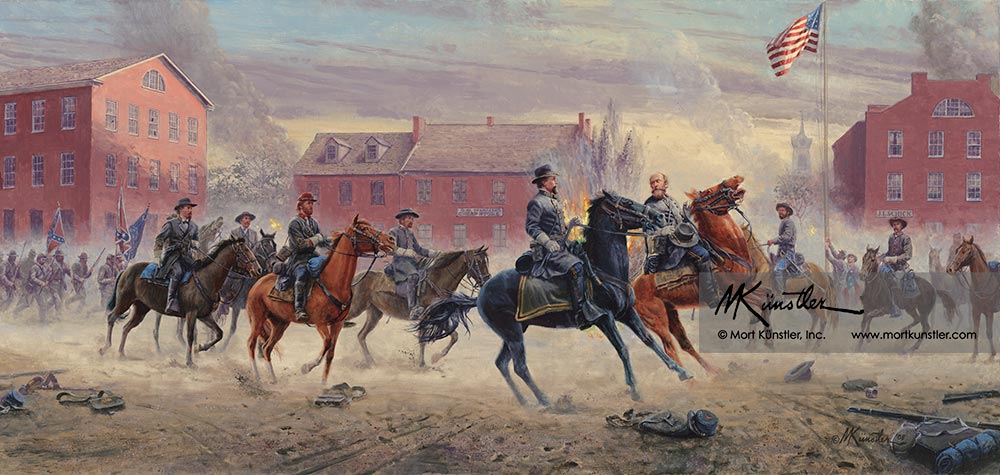Künstler
Are You Hurt, Sir?
Are You Hurt, Sir?
Couldn't load pickup availability
This is Mort Künstler limited edition print - Are You Hurt, Sir? Generals Gordan and Ewell Gettysburg, July 1, 1863.
LIMITED EDITION PRINT
Giclée Canvas Prints
Reproduction Technique: Giclées are printed with the finest archival pigmented inks on canvas. Each print is numbered and signed by the artist and accompanied by a Certificate of Authenticity.
Classic Edition 17” x 36”
Signed & Numbered • Edition Size: 250
Signed Artist's Proofs • Edition Size: 25
Historical Information
It appeared to be the victory the South was so desperately seeking. General Robert E. Lee and his triumphant Army of Northern Virginia had slipped away from their lines at Fredericksburg, Virginia and had skillfully made a forced march through the Shenandoah Valley, across the Potomac River and into Pennsylvania. There, Lee hoped to fight and win a major battle on Northern soil, ending America’s bloody Civil War and achieving Southern nationhood. He did not have long to wait. The North’s Army of the Potomac, newly commanded by Major General George Gordon Meade, hastily followed Lee’s army northward. Lee had 75,000 troops; Meade had about 105,000. The two collided at the Pennsylvania crossroads community of Gettysburg, where they engaged in a three-day contest that would become the largest battle ever fought in North America.
Two months earlier, Lee’s army had decisively defeated the Army of the Potomac at the battle of Chancellorsville – a victory that had enabled Lee to stage his invasion of the North. Would Lee be able to win again in Pennsylvania? On July 1, 1863, advance elements of both armies stumbled into each other at Gettysburg, and each side rushed troops to the battlefield. Lee’s army managed to get more men there first, and after a day of fierce fighting east and northeast of town, the Federal line finally broke. Northern troops fell back in disorder through Gettysburg, and re-formed on Cemetery Ridge south of town.
Meanwhile, Lee’s triumphant troops advanced into Gettysburg. Still under artillery fire, Confederate Lieutenant General Richard S. Ewell led Lee’s Second Corps into the town square, accompanied by one of his brigade commanders, Brigadier General John B. Gordon. Both men had barely survived earlier battles: Gordon had been wounded five times at the battle of Antietam, and General Ewell had lost his left leg at Second Manassas. Courageous and capable in combat, Ewell was reconnoitering the Federal position at Gettysburg with Gordon, when he was shot in the leg by a Northern sharpshooter. “Are you hurt, Sir?” Gordon asked anxiously. Reassuring him, Ewell explained, “It don’t hurt at all to be shot in a wooden leg.” Although later saddled with blame for failing to capture Gettysburg’s vitally important Cemetery Hill, Ewell and his corps were greatly responsible for the Confederate victory on the battle’s first day. It was late afternoon when General Ewell rode victoriously into the town square amid his cheering troops. It would be a fleeting triumph, however: The next two days of battle would go against the South. Gettysburg would prove to be a crucial Northern win and the turning point of the Civil War.
Mort Künstler’s Comments
Gettysburg was such an important battle, and holds such fascination for so many students of the Civil War. That’s why I’ve painted numerous Gettysburg subjects over the years, and continue to do so. One historian has observed that my Gettysburg artworks form a pictorial time-line of the battle. The latest to date – and one of my favorites – is “Are You Hurt, Sir?” It features two battle-scarred Confederate leaders in a triumphant and chaotic scene following the first day’s fighting. Though their southern troops were energized by the initial victory, the critically important battle would end two days later in a decisive Northern victory that would be the turning point of the war.
At the time of this new painting, Northern troops have been driven from their lines outside of town and back through Gettysburg. Fighting is still, however, going on in the town, depicted by the artillery fire seen in the background, and the excited, but guarded, actions of the Southern troops streaming into the town square. Look closely and you can see Northern kepis on the ground, bearing the corps badge of the Union XI Corps, which was forced to retreat on Gettysburg’s first day. Also seen in the background is another historical event: Soldiers from the 1st South Carolina Infantry are taking down the Union flag to replace it with the Confederate banner to celebrate victory. “Are You Hurt, Sir?” is the only painting I’ve done that depicts the fighting that occurred in town – an event that has been rarely recorded in Gettysburg artworks. In the background on the left is the Wills House, where President Abraham Lincoln would later spend the night when he came to town for his Gettysburg Address in November of 1863. Also seen in this painting are four more historic structures still recognizable to anyone who visits Gettysburg today.
At center stage in “Are You Hurt, Sir?” is General Richard Ewell and one of his key commanders, General John Brown Gordon. Ewell is one of my favorite Civil War figures. He was a very gifted commander who distinguished himself in battle and had driven Northern forces from Winchester, Virginia while on the march to Gettysburg. Ewell played a pivotal role in winning Gettysburg’s first day for the South, but he has been unfavorably compared to General Stonewall Jackson, who died shortly before Gettysburg. I’ve always felt that was unfair to Ewell. Who was equal to Stonewall Jackson?
Ewell was a bald-headed, eccentric officer whose appearance caused his soldiers to call him “Old Bald Head,” but they loved him and respected his bravery and skill. And they followed him faithfully: His corps had advanced deep into Pennsylvania – all the way to Carlisle – when Lee called them back to do battle at Gettysburg. I painted General Gordon at the battle of Cedar Creek in Shenandoah Sunrise, but this was my first time painting General Ewell – and it was long overdue. Astute observers will note that I’ve accurately depicted the time of day with later afternoon sunlight, and I’ve also lit the Union flag with it, symbolizing the fact that the Union would prevail at Gettysburg. I think that “Are You Hurt, Sir?” enhances the collection of Gettysburg paintings I’ve been able to produce, and records an important and colorful historic event from the Civil War.
Share


Continue Shopping
See more of the Breagans' collection of manufacturers from all around the world
Subscribe to our emails
Subscribe to our mailing list for insider news, product launches, and more.

